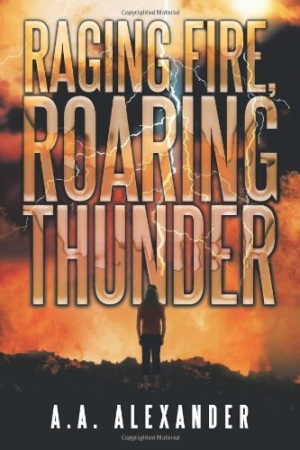Raging Fire, Roaring Thunder
The author of three nonfiction books, architectural engineer A. A. Alexander tries his hand at his first novel with Raging Fire, Roaring Thunder. The book chronicles the trials and triumphs of Ryan Stewart and Betsy Miller, a couple whose attraction ignites in 1975 as Ryan’s house catches fire when they are both adolescents. Although their love grows, various obstacles conspire to keep them apart, as Betsy becomes a nurse and Ryan goes into architecture. A clandestine liaison during a thunderstorm may forever prevent them from being together.
Ryan and Betsy remain likable characters, from the poignant moment when she comforts him during the fire through the exquisitely rendered agony each feels at being away from the other. In a refreshing gender turnabout, Ryan seems to pine more for Betsy, while practical Betsy sublimates her desire in an attempt to move on and attract another man. Both plunge into school and work.
As Betsy graduates from high school in 1979 and college four years later, her friends Jennie and Kathy just want to snag men and marry, while she wants a career and a man. Alexander deftly captures these two prevailing attitudes about women’s roles in the 1980s. Although Betsy pursues the typical feminine job of a nurse, her careerism is admirable considering how many secondary women in the story want males to provide for them.
In another ingenious twist, Ryan and Betsy do fall for, and get engaged to, Ashley and Paul, respectively, in the interceding years, thereby overturning the cliché that one can only ever adore one’s true love. Even better, readers will empathize with Ashley and Paul because they buck the trend of stand-in lovers whom the readers can see are obviously wrong for the heroes. They are ambitious, sweet people who share mutual affection for their partners, just not the kind of enduring love Ryan and Betsy have for each other.
Unfortunately, Alexander summarizes many of the conversations between the characters that solidify traits or relationships. After the initial scene of comfort in the wake of the fire, much of Ryan and Betsy’s relationship gets reported through summary paragraphs, with liberal use of asterisks to denote the passage of time. The audience knows Betsy is practical because the author repeatedly says so. Likewise, the business about the burning of Ryan’s childhood home is over by page forty-five, and suddenly Ryan is a freshman in high school. Amy, Ryan’s little sister, is never mentioned again after the fire. The deaths of Ryan’s father and grandfather are played up in the beginning but rarely alluded to as the narrative continues, which is odd considering how much Alexander makes of the boy adoring both men. On the flip side, however, Alexander often uses direct dialogue for mundane discussions about meals.
The author’s engineering background gets in the way as the story delves into Ryan’s study of architecture. If Alexander had spent as much time scaffolding his characters and their circumstances with the amount of detail he uses to describe Ryan’s buildings, Raging Fire, Roaring Thunder would spark more interest.
Reviewed by
Jill Allen
Disclosure: This article is not an endorsement, but a review. The publisher of this book provided free copies of the book and paid a small fee to have their book reviewed by a professional reviewer. Foreword Reviews and Clarion Reviews make no guarantee that the publisher will receive a positive review. Foreword Magazine, Inc. is disclosing this in accordance with the Federal Trade Commission’s 16 CFR, Part 255.

